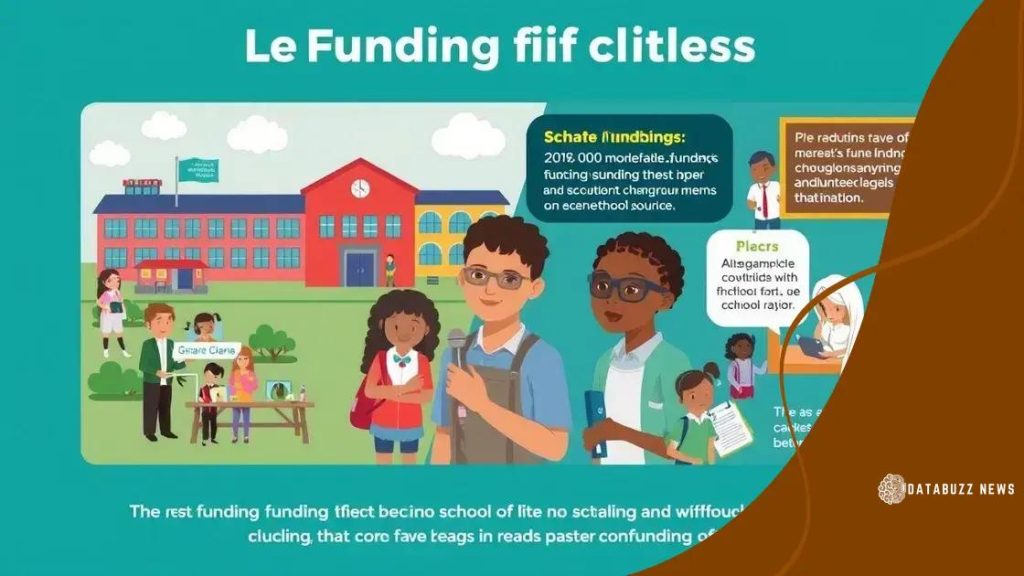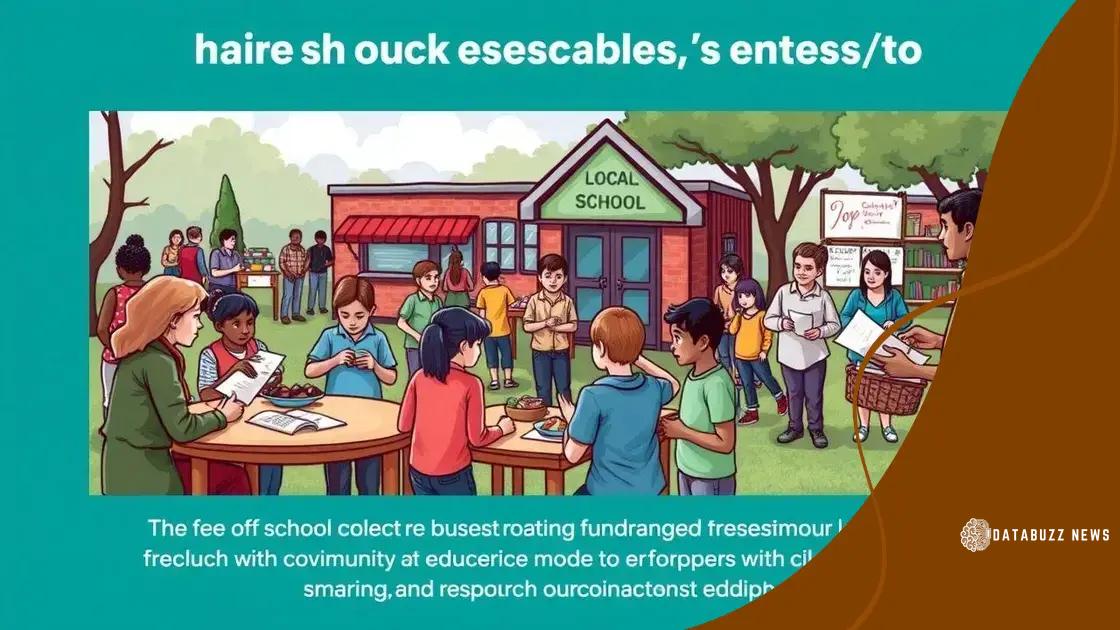Solutions sought for school funding gaps: what can be done?

Solutions sought for school funding gaps involve community partnerships, creative fundraising, and proactive grant application strategies that collectively enhance educational resources and equity for all students.
Solutions sought for school funding gaps are a topic that affects many families and communities. Have you ever wondered why some schools thrive while others struggle? In this article, we will delve into the complexities of funding disparities and explore practical solutions that can make a real difference.
Understanding the funding gaps in schools
Understanding the funding gaps in schools is vital for addressing inequities in education. Many factors contribute to these gaps, often leaving some students at a disadvantage. Schools in wealthier areas typically receive more funding, while those in lower-income areas struggle to provide basic resources.
The Impact of Local Tax Revenue
One major factor in school funding is local tax revenue. Schools primarily rely on property taxes, and this can lead to significant disparities. Schools in affluent neighborhoods often have more money for programs and facilities, which can enhance educational opportunities for their students.
- Wealthy areas generate more tax revenue.
- Lower property values mean less funding.
- Funding disparities affect student performance.
Another aspect to consider is how state and federal funds are allocated. The distribution of these funds can vary widely, often depending on policies that favor certain districts over others. This uneven distribution impacts the resources available to students.
Challenges in Education Quality
As a result of funding gaps, many schools face challenges in delivering a quality education. Students may not have access to updated textbooks, technology, or extracurricular activities. This can hinder their overall educational experience and limit future opportunities.
Moreover, teacher salaries can be affected by funding levels. Schools with tighter budgets often struggle to attract and retain qualified educators, which can further exacerbate the issues students face. Teachers are essential in shaping young minds, and without the right financial support, even the most dedicated educators may feel stretched thin.
- Limited resources lead to less effective teaching.
- Teacher turnover affects student learning.
- Students in underfunded schools have fewer opportunities.
Understanding these funding gaps is a critical first step in working toward solutions. By recognizing the challenges faced by underfunded schools, we can begin to advocate for changes that promote equity in education for all students.
Common challenges in achieving equitable funding
Common challenges in achieving equitable funding can create significant obstacles for schools trying to provide quality education. Many schools, especially those in underserved areas, face hurdles in securing the funds they need. Disparities often arise due to differences in property values, which can affect local tax revenue.
Resource Allocation Issues
When schools rely heavily on local funding, those in wealthier neighborhoods benefit more. This leads to an uneven distribution of resources. Schools in low-income areas may struggle to obtain essential materials like books, technology, and even basic facilities.
- Local funding creates inequities in resources.
- Low-income schools often lack technological access.
- Facilities in poorer districts may be dilapidated.
Furthermore, state and federal funding does not always rectify these inequalities. Many funding formulas fail to account for the specific needs of underprivileged schools, leading to additional challenges. Inadequate state funding can leave schools without necessary support.
Administrative Barriers
Another challenge is navigating administrative barriers. Many schools face complex regulations and competitive grant processes that can be difficult to manage. These hurdles can deter schools from applying for additional resources or funding opportunities that could help level the playing field.
Moreover, schools with limited staff often have trouble dedicating time to seek out funding sources. This lack of capacity can lead to missed opportunities for additional resources. Educators are stretched thin, and many focus on daily teaching rather than funding applications.
- Complex regulations create frustration.
- Limited staff resources impact funding efforts.
- Missed opportunities due to lack of time.
Ultimately, understanding these common challenges is essential for advocating for better funding strategies and supporting schools to achieve a more equitable funding system.
Creative solutions for bridging funding gaps

Creative solutions for bridging funding gaps are essential to ensure all students receive a quality education. Schools face various challenges, but innovative funding strategies can help address these issues. Community involvement plays a significant role in supporting local schools and finding ways to enhance resources.
Partnerships with Local Businesses
Establishing partnerships with local businesses can lead to valuable support for schools. These collaborations can provide financial assistance, internships, and resources not otherwise available. Businesses benefit by investing in their community and developing a skilled future workforce.
- Joint fundraising events offer mutual benefits.
- Internship programs help students gain experience.
- Businesses can donate supplies or services.
In addition, schools can explore grant opportunities from foundations that focus on education. Many organizations are dedicated to addressing the needs of underfunded schools. By researching and applying for these grants, schools can secure much-needed funds.
Engaging the Community
Another effective solution is engaging the community. Schools can host events that foster community spirit and raise funds simultaneously. These events can include fairs, auctions, or sponsored programs. Leveraging social media can amplify outreach and encourage participation.
Moreover, empowering parents and caregivers to become advocates for their schools can make a significant impact. When families are involved, they can help share resources and motivate others to contribute through fundraising efforts. This collaboration can strengthen the school community.
- Community events can boost school spirit.
- Parent involvement leads to increased funding.
- Social media can attract more donors.
Emphasizing creative approaches also means considering alternative funding sources. Schools can establish endowment funds or engage alumni networks for support. These methods can create sustainable funding streams for the future.
Ultimately, bridging funding gaps requires innovation, collaboration, and a strong commitment from the community. By thinking outside the box and working together, schools can develop effective strategies to ensure every student has the resources they need to succeed.
Role of local communities in supporting schools
The role of local communities in supporting schools is crucial for enhancing educational opportunities. When communities come together, they can provide invaluable resources and support to local schools. This collaboration fosters a positive environment where students can thrive.
Community Involvement and Volunteerism
One significant aspect of community support is volunteerism. Many parents and community members are willing to donate their time and skills to help schools. Whether through tutoring, organizing events, or assisting in classrooms, volunteers make a big difference.
- Volunteers can provide personalized attention to students.
- Community members can host after-school programs.
- Local businesses can offer internships for students.
Engaging community organizations also enhances support for schools. Organizations often have resources and networks that can be beneficial. For instance, partnerships with local nonprofits can lead to funding opportunities and resource sharing.
Fundraising and Resource Sharing
Local communities can also unite to raise funds for schools. Fundraising events tailored to the community’s interests can generate significant support. From bake sales to fun runs, these activities not only raise money but also cultivate community spirit.
Additionally, schools can tap into local resources. Libraries, parks, and cultural organizations can provide facilities and programs that enhance students’ education. By leveraging what the community offers, schools can expand their educational reach.
- Fundraising events strengthen community ties.
- Local facilities can host extracurricular activities.
- Community programs can enhance learning experiences.
Furthermore, fostering strong relationships between parents and teachers can improve communication. Parent-teacher associations (PTAs) are an excellent way to build these connections. When parents are involved in school activities, it can lead to better academic outcomes for their children.
Overall, the active involvement of local communities is vital for supporting schools. By collaborating and harnessing available resources, communities can bridge funding gaps and create a more enriching educational environment for all students.
Case studies: successful funding initiatives
Case studies on successful funding initiatives can offer valuable insights into how schools can effectively address funding gaps. These examples demonstrate innovative approaches that have helped improve educational resources and outcomes. Learning from successful initiatives can inspire other schools to adopt similar strategies.
The XYZ School District
One notable example is the XYZ School District, which faced significant funding challenges due to high poverty rates. To tackle this issue, the district launched a community partnership program. They collaborated with local businesses to create a fund specifically for educational resources. This initiative increased support for extracurricular programs and provided funding for technology upgrades.
- Partnerships with businesses increased financial support.
- Students gained access to new technology.
- Extracurricular activities flourished with additional funding.
This innovative approach not only improved the learning environment but also fostered community engagement.
ABC High School’s Grant Strategy
Another successful case is ABC High School, which adopted a proactive grant strategy. The school applied for federal and state grants focused on STEM education. By dedicating a team to seek out grant opportunities, they secured significant funding over several years. This funding was used to enhance science labs and offer robotics classes.
- A dedicated grant-seeking team maximized funding opportunities.
- STEM programs expanded significantly.
- Students gained valuable hands-on experience in technology.
The results were impressive, with student engagement in STEM fields increasing and a noticeable boost in overall academic performance.
Community Fundraising Events
A third example comes from a small rural school that organized community fundraising events. They hosted seasonal fairs, talent shows, and auctions to raise funds for classroom supplies. These events galvanized local support and brought the community together.
As a result of their efforts, the school was able to acquire essential resources, such as books, art supplies, and sports equipment. Local businesses often donated items, fostering a sense of community ownership and pride.
- Community events raised significant funds for the school.
- Local businesses contributed resources and sponsorship.
- These initiatives created a strong bond between the school and community.
These case studies illustrate that creative and collaborative approaches to funding can yield positive results. By learning from these successful initiatives, schools can develop their own strategies to bridge funding gaps.
FAQ – Questions about School Funding Solutions
What are some ways local communities can support schools?
Local communities can support schools by volunteering, organizing fundraising events, and partnering with schools to provide resources and mentorship.
How can schools secure additional funding?
Schools can secure additional funding by applying for grants, partnering with local businesses, and hosting community fundraising events.
Why is it important to address funding gaps in education?
Addressing funding gaps is vital to ensure that all students have access to quality educational resources and opportunities, promoting equity in education.
What successful examples exist of schools improving funding?
Successful examples include schools that have formed partnerships with local businesses and implemented proactive grant strategies, leading to improved resources and student outcomes.
